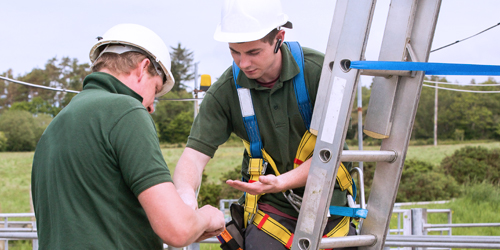
By Tann Nichols, MD
If you think ladder injuries are rare, think again. In the United States more than 500,000 people are treated for ladder-related injuries each year, and about 300 people die, according to the Centers for Disease Control and Prevention. The estimated annual cost of these ladder injuries is $24 billion, a figure that includes lost time at work and expenses related to treatment and legal issues. From 2000 to 2009, 43 percent of fatal falls in the United States involved a ladder.
Ladder injuries are so common, in fact, that the World Health Organization has assigned three separate statistical classifications (ICD codes) to them – one for the initial encounter with a clinician, one for a subsequent encounter, and one – sadly – for after-effects of a ladder-related injury.
People who suffer ladder injuries tend to be male, older, self-employed, or employed in businesses related to construction or maintenance. Injuries also occur to regular home-owners and do-it-yourselfers of all ages.
I personally see less than a dozen ladder-related injuries in my neurosurgical practice each year, because most people who fall from ladders do not get hurt too badly. The patients I do see range from those who have suffered mild head injuries to those with devastating intracranial hemorrhages. Deaths are rare but can occur even in cases of relatively short falls of 10 feet or less.
I sometimes see fractures of the cervical spine, or neck, and I frequently see fractures to the transverse process in the lower back, a bony extension of the vertebra that extends outward, left and right, from the vertebral center. This usually occurs when the patient has fallen flat on their back. Another classic ladder injury is a burst fracture in the lower back (usually at L5) that occurs when someone falls off and lands on their feet; this transmits all the energy up their legs and into their back.
Ladder injuries occur in many ways. Some people slip off a ladder rung and fall straight down. Oftentimes they lean too far to one side or the ladder is not well braced on a flat surface.
Ladder injuries occur throughout the year, though most frequently in the fall. People fall from deer stands, while trimming tree limbs or cleaning gutters, and when hanging Christmas lights. Risk is enhanced when people are carrying too much stuff, are under the influence of alcohol, or are simply not paying attention.
Sometimes a ladder is not even involved. My grandfather, who used a small box as a stepstool, fell and broke his hip. His hip did not heal after the first surgery and he died of complications following his second operation.
So now the positive news. If you are going to use a ladder, you can enhance your safety by following proven safety protocols:
• Use a ladder that is in good shape. Properly dispose of any ladder that is not in good shape.
• Use the appropriate tool for the job; no standing on chairs or tables.
• Stepstools are ladders, too, and should be shown the same respect as their taller cousins.
• Wear clean, slip-resistant footwear with a defined heel (no leather soles or flip-flops).
• Make sure the ladder is stable and secure. It should be firmly braced at the bottom and against whatever it is leaning against. The optimal setup angle is 75 degrees. A significant percentage of injuries occur when a ladder has slid out at the base due to an incorrect setup angle.
• Don’t extend more than half of your body beyond the side of the ladder.
• Never climb more than waist high above the top of the ladder.
• If you have poor balance or dizziness, just don’t do it. Hire someone who is properly trained and accustomed to working with ladders.
It is worth noting that a neurological concept — proprioception – plays an important role in ladder safety. Proprioception involves our sense and understanding of where our body is in space. Our eyes and ears relay some of this information to our central nervous system, but we also have sensors along the plantar surface of our feet that tell the brain whether our body is leaning in a certain direction. This system is most effective when our feet are positioned on a firm, flat surface. An unstable surface – such as a tilting ladder – will negatively impact this protective evolutionary mechanism.
With spring cleaning just around the corner, take a moment to mark National Ladder Safety Month. And share these safety tips with your friends and loved ones!
For more information, check out these sources:
• National Ladder Safety Month, which is sponsored by the American Ladder Institute, seeks to “heighten awareness, reinforce safety training, and educate homeowners and workers.”
• The Centers for Disease Control and Prevention and the National Institute for Occupational Safety and Health (NIOSH) offer a Ladder Safety App
_______________________________________
Tann Nichols, MD, is a neurosurgeon with Mayfield Brain & Spine and a practitioner at St. Elizabeth Healthcare.